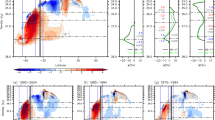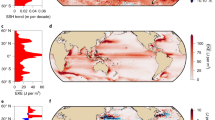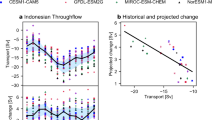Abstract
Observations show a significant intensification of the Southern Hemisphere westerlies, the prevailing winds between the latitudes of 30∘ and 60∘ S, over the past decades. A continuation of this intensification trend is projected by climate scenarios for the twenty-first century. The response of the Antarctic Circumpolar Current and the carbon sink in the Southern Ocean to changes in wind stress and surface buoyancy fluxes is under debate. Here we analyse the Argo network of profiling floats and historical oceanographic data to detect coherent hemispheric-scale warming and freshening trends that extend to depths of more than 1,000 m. The warming and freshening is partly related to changes in the properties of the water masses that make up the Antarctic Circumpolar Current, which are consistent with the anthropogenic changes in heat and freshwater fluxes suggested by climate models. However, we detect no increase in the tilt of the surfaces of equal density across the Antarctic Circumpolar Current, in contrast to coarse-resolution model studies. Our results imply that the transport in the Antarctic Circumpolar Current and meridional overturning in the Southern Ocean are insensitive to decadal changes in wind stress.
This is a preview of subscription content, access via your institution
Access options
Subscribe to this journal
Receive 12 print issues and online access
$259.00 per year
only $21.58 per issue
Buy this article
- Purchase on Springer Link
- Instant access to full article PDF
Prices may be subject to local taxes which are calculated during checkout





Similar content being viewed by others
References
Rintoul, S. R., Hughes, C. W. & Olbers, D. in Ocean Circulation Climate (eds Siedler, G., Church, J. & Gould, J.) 271–302 (Academic, 2001).
IPCC, in Climate Change 2007: The Physical Science Basis. Contribution of Working Group I to the Fourth Assessment Report of the Intergovernmental Panel on Climate Change (eds Solomon, S., et al.) 1009 (Cambridge Univ. Press, 2007).
Toggweiler, J. R. & Russell, J. Ocean circulation in a warming climate. Nature 451, 286–288 (2008).
Levitus, S., Antonov, J., Boyer, T. P. & Stephens, C. Warming of the world ocean. Science 287, 2225–2229 (2000).
Barnett, T. P. et al. Penetration of human-induced warming into the world’s oceans. Science 309, 284–287 (2005).
Levitus, S., Antonov, J. & Boyer, T. Warming of the world ocean. Geophys. Res. Lett. 32, L02604 (2005).
Willis, J. K., Roemmich, D. & Cornuelle, B. Interannual variability in upper ocean heat content, temperature, and thermosteric expansion on global scales. J. Geophys. Res. 109, 10.1029/2003JC002260 (2004).
Sabine, C. L. et al. The oceanic sink for anthropogenic CO2 . Science 305, 367–371 (2004).
Mikaloff Fletcher, S. E. et al. Inverse estimates of anthropogenic CO2 uptake, transport, and storage by the ocean. Glob. Biogeochem. Cycles 20, 10.1029/2005GB002530 (2005).
Zickfeld, K., Fyfe, J. C., Saenko, O. A., Eby, M. & Weaver, A. J. Response of the global carbon cycle to human-induced changes in the Southern Hemisphere winds. Geophys. Res. Lett. 34, 10.1029/2006GL028797 (2007).
Lenton, A. & Matear, R. J. Role of the Southern Annular Mode (SAM) in Southern Ocean CO2 uptake. Glob. Biogeochem. Cycles 21, GB2016 (2007).
Lovenduski, N. S., Gruber, N. & Doney, S. C. Toward a mechanistic understanding of the decadal trends in the Southern Ocean carbon sink. Glob. Biogeochem. Cycles 22, 10.1029/2007GB003139 (2008).
Fyfe, J. C. & Saenko, O. A. Simulated changes in extratropical Southern Hemisphere winds and currents. Geophys. Res. Lett. 33, L06701 (2006).
Yin, J. H. A consistent poleward shift of the storm tracks in simulations of 21st century climate. Geophys. Res. Lett. 32, L18701 (2005).
Bi, D., Budd, W. F., Hirst, A. C. & Wu, X. Response of the Antarctic Circumpolar Current transport to global warming in a coupled model. Geophys. Res. Lett. 29, 10.1029/2002GL015919 (2002).
Saenko, O. A., Fyfe, J. C. & England, M. H. On the response of the oceanic wind-driven circulation to atmospheric CO2 increase. Clim. Dyn. 25, 415–426 (2005).
Hall, A. & Visbeck, M. Synchronous variability in the Southern Hemisphere atmosphere, sea ice, and ocean resulting from the annular mode. J. Clim. 15, 3043–3057 (2002).
Oke, P. R. & England, M. H. Oceanic response to changes in the latitude of the Southern Hemisphere subpolar westerly winds. J. Clim. 17, 1040–1054 (2004).
Sen Gupta, A. & England, M. H. Coupled ocean–atmosphere–ice response to variations in the Southern Annular Mode. J. Clim. 19, 4457–4486 (2006).
Hallberg, R. & Gnanadesikan, A. The role of eddies in determining the structure and response of the wind-driven Southern Hemisphere overturning: Initial results from the Modelling Eddies in the Southern Ocean project. J. Phys. Oceanogr. 36, 3312–3330 (2006).
Hogg, A. McC., Meredith, M. P., Blundell, J. R. & Wilson, C. Eddy heat flux in the Southern Ocean: Response to variable wind forcing. J. Clim. 21, 608–620 (2008).
Screen, J. A., Gillett, N. P., Stevens, D. P., Marshall, G. J. & Roscoe, H. K. The role of eddies in the Southern Ocean temperature response to the Southern Annular Mode. J. Clim. (in the press, 2008).
Thompson, D. W. L. & Solomon, S. Interpretation of recent Southern Hemisphere climate change. Nature 296, 895–899 (2002).
Marshall, G. J. Trends in the Southern Annular Mode from observations and reanalyses. J. Clim. 16, 4134–4143 (2003).
Meredith, M. P. & Hogg, A. M. Circumpolar response of Southern Ocean eddy activity to a change in the Southern Annular Mode. Geophys. Res. Lett. 33, 10.1029/2006GL026499 (2006).
Gille, S. T. Warming of the Southern Ocean since the 1950s. Science 295, 1275–1277 (2002).
Gille, S. T. Decadal-scale temperature trends in the Southern Hemisphere. J. Clim. 21, 4749–4765 (2008).
Roemmich, D. et al. in Observing the Oceans in the 21st century (eds Koblinsky, C. J. & Smith, N. R.) 248–258 (GODAE Project Office and Bureau of Meteorology, 2001).
Ridgway, K. R., Dunn, J. R. & Wilkin, J. L. Ocean interpolation by four-dimensional weighted least squares—application to the waters around Australia. J. Atmos. Oceanic Tech. 19, 1357–1375.
Jackett, D. R. & McDougall, T. J. A neutral density variable for the world’s ocean. J. Phys. Oceanogr. 27, 237–263 (1997).
Aoki, S., Bindoff, N. L. & Church, J. A. Interdecadal water mass changes in the Southern Ocean between 30∘ E and 160∘ E. Geophys. Res. Lett. 32, L07607 (2005).
Wong, A. P. S., Bindoff, N. L. & Church, J. A. Freshwater and heat changes in the North and South Pacific oceans between the 1960s and 1985–94. J. Clim. 14, 1613–1633 (2001).
Bindoff, N. L. & McDougall, T. J. Decadal changes along an Indian Ocean section at 32∘ S and their interpretation. J. Phys. Oceanogr. 30, 1207–1222 (2000).
Bryden, H. L., McDonagh, E. L. & King, B. A. Changes in ocean water mass properties: Oscillations or trends? Science 300, 2086–2088 (2003).
Bindoff, N. L. & Church, J. A. Warming of the water column in the southwest Pacific Ocean. Nature 357, 59–62 (1992).
Johnson, G. C. & Orsi, A. H. Southwest Pacific Ocean water-mass changes between 1968/69 and 1990/91. J. Clim. 10, 306–316 (1997).
Banks, H. T. & Bindoff, N. L. Comparison of observed temperature and salinity changes in the Indo–Pacific with results from the coupled climate model HadCM3: Processes and mechanisms. J. Clim. 16, 156–166 (2003).
Bindoff, N. L. & McDougall, T. J. Diagnosing climate change and ocean ventilation using hydrographic data. J. Phys. Oceanogr. 24, 1137–1152 (1994).
Fyfe, J. C., Saenko, O. A., Zickfeld, K., Eby, M. & Weaver, A. J. The role of poleward-intensifying winds on Southern Ocean warming. J. Clim. 20, 5391–5400 (2007).
Held, I. M. & Soden, B. J. Robust responses of the hydrological cycle to global warming. J. Clim. 19, 5686–5699 (2006).
Borowski, D., Gerdes, R. & Olbers, D. Thermohaline and wind forcing of a circumpolar channel with blocked geostrophic contours. J. Phys. Oceanogr. 32, 2520–2540 (2002).
Rintoul, S. R., Sokolov, S. & Church, J. A 6 year record of baroclinic transport variability of the Antarctic Circumpolar Current at 140∘ E derived from expendable bathythermograph and altimeter measurements. J. Geophys. Res. 107, 10.1029/2001JC000787 (2002).
Lovenduski, N. S., Gruber, N., Doney, S. C. & Lima, I. D. Enhanced CO2 outgassing in the Southern Ocean from a positive phase of the Southern annular Mode. Glob. Biogeochem. Cycles 21, GB2026 (2007).
Verdy, A., Dutkiewicz, S., Follows, M. J., Marshall, J. & Czaja, A. Carbon dioxide and oxygen fluxes in the Southern Ocean: Mechanisms of interannual variability. Glob. Biogeochem. Cycles 21, GB2020 (2007).
Le Quéré, C. et al. Saturation of the Southern Ocean CO2 sink due to recent climate change. Science 316, 1735–1738 10.1126/science.1136188 (2007).
Law, R. M., Matear, R. J. & Francey, R. J. Comment on ‘Saturation of the Southern Ocean CO2 sink due to recent climate change’. Science 319, 570a (2008).
Zickfeld, K., Fyfe, J. C., Eby, M. & Weaver, A. J. Comment on ‘Saturation of the Southern Ocean CO2 sink due to recent climate change’. Science 319, 570b (2008).
Le Quéré, C. et al. Response to comments on ‘Saturation of the Southern Ocean CO2 sink due to recent climate change’. Science 319, 570c (2008).
Gent, P. R. & McWilliams, J. C. Isopycnal mixing in ocean circulation models. J. Phys. Oceanogr. 20, 150–155.
Dunn, J. R. & Ridgway, K. R. Mapping ocean properties in regions of complex topography. Deep-Sea Res. I 49, 591–604 (2002).
Acknowledgements
We acknowledge the role of J. Dunn in developing and making available the CSIRO ocean data archives, and K. Lorbacher for her assistance in the data analysis. The study was initiated during visits of C.W.B. and A.D. at CSIRO Marine Research Laboratories in Hobart, supported by an Ernst Froehlich Fellowship (C.W.B.) and a grant from DAAD (A.D.). This research was supported in part by the CSIRO Wealth from Oceans Flagship, the Australian government’s Cooperative Research Centre (CRC) programme through the ACE CRC, and the Australian Greenhouse Office. The paper is a contribution to The Future Ocean Cluster at Kiel University.
Author information
Authors and Affiliations
Corresponding author
Supplementary information
Supplementary Information, Fig. S1
Supplementary Information (PDF 1022 kb)
Rights and permissions
About this article
Cite this article
Böning, C., Dispert, A., Visbeck, M. et al. The response of the Antarctic Circumpolar Current to recent climate change. Nature Geosci 1, 864–869 (2008). https://doi.org/10.1038/ngeo362
Received:
Accepted:
Published:
Issue Date:
DOI: https://doi.org/10.1038/ngeo362
This article is cited by
-
Persistent warm-eddy transport to Antarctic ice shelves driven by enhanced summer westerlies
Nature Communications (2024)
-
The southward migration of the Antarctic Circumpolar Current enhanced oceanic degassing of carbon dioxide during the last two deglaciations
Communications Earth & Environment (2024)
-
What induced the trend shift of mixed-layer depths in the Antarctic Circumpolar Current region in the mid-1980s?
Acta Oceanologica Sinica (2024)
-
Isotopic evidence for an intensified hydrological cycle in the Indian sector of the Southern Ocean
Nature Communications (2023)
-
The role of water mass advection in staging of the Southern Ocean Salpa thompsoni populations
Scientific Reports (2023)



